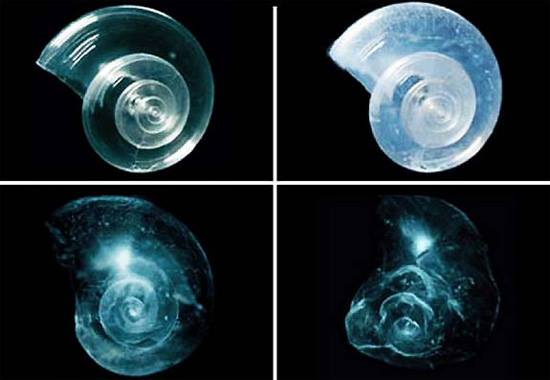Shells are the protective shield for the soft parts of bivalve molluscs, such as clams, mussels and oysters, and gastropods, such as snails. They protect them from drying out and from predators, although some are specialised in breaking these shields, such as the oystercatcher, a bird with a very hard beak capable of opening the shells of the strongest bivalves.
Just as our cells build our bones, mollusks build their shells. These grow in thickness from the inside and in surface area along the edges, because these are the areas that are in contact with the mantle, which is the tissue of the soft part of the animal responsible for depositing the material from which the shell is made.
This hard shell is mostly made of a common molecule, calcium carbonate (stalactites, for example, are made of this substance), in the form of crystals embedded in a pool of proteins and polysaccharides (called conchiolin). Mollusks extract calcium from their food, water, rocks and the environment. They reach the mantle through the bloodstream, which concentrates them and transforms them into crystals, which are deposited in layers.
Mother of pearl with iridescent shine
There are three layers, composed of the same substances but in different proportions and crystallized in different ways. The inner layer is mother-of-pearl, formed by tightly packed and ordered layers, whose iridescent shine captivates jewelry designers. The middle layer is less compact. The outermost layer is located at the edge and is mostly made of conchiolin.
Shells do not grow constantly. They grow according to environmental conditions and the availability of food. Like tree rings, you can read growth lines on shells and find out if the mollusk has gone through a particularly adverse period.
The colour pattern depends on the species and serves to camouflage and give the shell a hardness. The pigments are obtained through the food they eat, which are metabolic waste products that accumulate in the shell. If they eat the same thing regularly, the shell will have a uniform colour. If they do not, the shell will have streaks and speckles.
Acidic oceans dissolve shells
Climate change is a threat to shelled organisms. The oceans absorb 25 % of the carbon dioxide emissions we emit. Carbon dioxide is a gas that turns into acid when it comes into contact with water. This is harmful to shelled organisms, since calcium carbonate dissolves in acidic water and disappears. Surface waters in the oceans have already become 0.1 pH units more acidic than pre-industrial levels. Future acidification will depend on the carbon dioxide emitted from now on, but forecasts suggest that it will increase by 0.4 more units by the end of the 21st century. This is how the shells of a sea butterfly, which are part of the plankton, break down in a laboratory simulation made by photographer David Littschwager for National Geographic.
Written by: America Valenzuela








